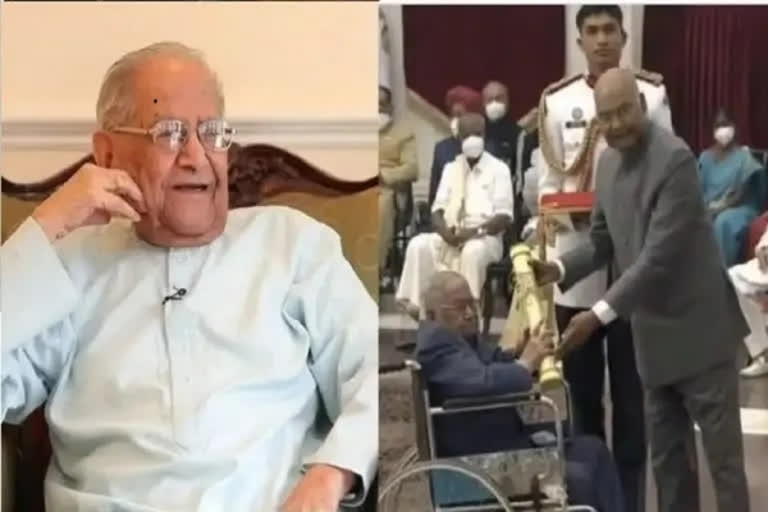New Delhi: Archaeologist Dr B B Lal passed away last week. Through his discoveries, he gave a new direction to Indian archaeology. He worked as a trainee in the excavations of Taxila and Harappa with the famous British archaeologist Mortimer Wheeler, and after independence, between 1950 and 1952, excavated Hastinapur mentioned in the Mahabharata.
Later from 1975-76, he also worked in four places including Ayodhya. His disciple and archaeologist, Dr KK Mohammed, who worked with him in excavating sites related to Ramayana in 1976, shared memories of his mentor Dr Lal with ETV Bharat.
“He used to say that the job of an archaeologist is the same as that of a doctor to do a postmortem. During the postmortem, the doctor tells how and why the death happened. He should not see whether the person who died was a Hindu or a Muslim. The work of an archaeologist is also similar. He has to do the work of archaeology keeping religion aside."
KK Muhammad, who learned the story of Archeology from his mentor Dr B. B. Lal said, “We all did our work in exactly the same way. I was also in the excavation of Ayodhya, being the only Muslim, we did not care about Islam or Hinduism. We were told what it was. Just like Mecca is important for Muslims, Ayodhya is for Hindus."
He said that Dr Lal's biggest contribution was that he excavated the places related to epics like Mahabharata and Ramayana and brought the truth about them to the ground. Before that, the things related to these two were considered mere fantasies. In the excavation of Hastinapur in 1952, the results which came out proved that Mahabharata is not just a story.
According to the remains found in the excavation of Hastinapur, after the Pandavas left for Vanaprastha, their descendants ruled in Hastinapur. But after a generation there was a severe flood, in which everything was washed away. Because of that the king travelled from Hastinapur to Kaushambi and went there and re-established his kingdom.
Also read: Central Vista Project to Jagannath Temple: Bimal Patel, the architect behind such urban landmarks
“Dr Lal did the excavation of Hastinapur, he found the remains of many generations there. The layer of the time after the flood was also found, it was a huge success. The description of this holocaust was given in 'Vayu Purana'. He wore the cloak of truth to the historicity of this incident. But at the same time it is also said that in the description of the battle found in the epic Mahabharata, there is a lot of redundancy. The events have been exaggerated,” said KK Muhammad.
"He also discovered the five villages given to the Pandavas by the Kauravas. Tilpat, Baghpat and Sonipat are among those which are the only areas around Delhi and Meerut. He excavated there too, where he found pottery at the bottom, which we call PGW i.e. Painted Greyware. This is a grey-coloured vessel, which was also found in Hastinapur. So it was thought that people of the Mahabharata period used such utensils. It was Dr B. B. Lal who brought all these revolutions to the field of archaeology."
KK Muhammad said what happened when the foundations of the pillars of the temple were found under the mosque in the excavation of Ayodhya. "Many idols surfaced. Dr Lal did not want to create controversy about what was found in the excavation at that time. But Marxist historians Romila Thapar, and RS Sharma started saying that no remains of the temple were found in the excavations done by BB Lal, so Muslims should not give this place to Hindus."
Marxist historians had good contacts in the newspapers, so these people did this bullying and started saying that no evidence was found in the excavation of the temple. So BB Lal also had to defend himself in the end. For this, all the things that he had found in the excavation, he put in front and had to say that all this has been found in the excavation and this proves that there was a temple under the mosque, he said.
KK Muhammad added: "This was from the 70s. Later, when I was deputy superintendent in Madras, I issued a statement in support of his discovery. I said in that statement that I am the only Muslim involved in the excavation under the direction of Dr Lal and am a witness that the excavation has found a temple under the mosque. I also said that Marxist historians have said everything about this without looking at the evidence. With that statement of mine, all of them stopped speaking."
Also read: Karnataka: Hindu sculptor's mosque carvings fascinates people
Asked whether any political pressure was on him during the excavation of Ayodhya, Muhammad said, “There was a Culture Minister, who was from Andhra Pradesh, who had objected to the discoveries of Dr Lal. Marxists were already angry with him. Dr Lal did not want to get into any controversy, so he voluntarily retired. Since he wanted to continue working for archaeology, he later joined the Institute of Archeology in Shimla. He taught us there too.



